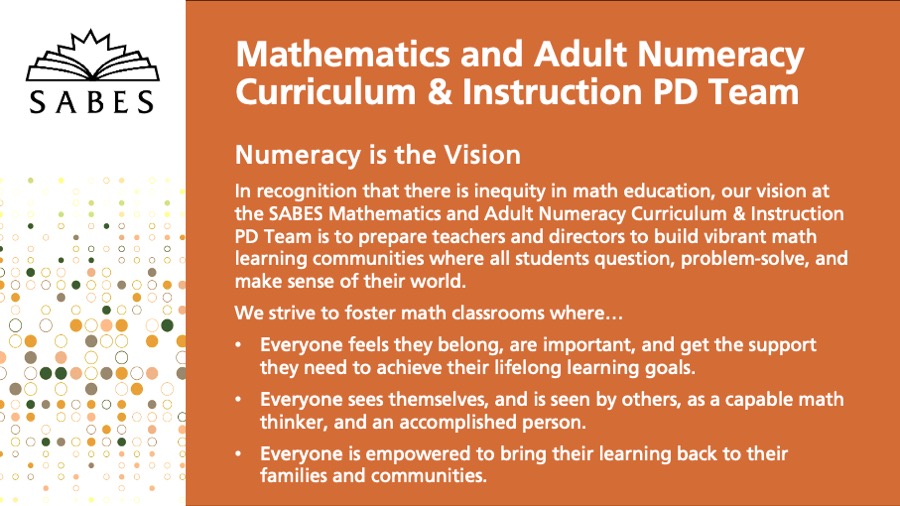Achieve a Big Effect Through Small Actions
For two years, SABES Math & Adult Numeracy (M&N) consultant Lakshmi Nayak had a visually impaired, legally blind student. This article highlights what she learned, and includes tips and strategies from the M&N team.
"Yes, she did pass and earn her HiSET, and along the way I learned a lot. It was an excellent learning experience for me.
I learned to be better organized and prepare in advance. Using the classroom website I had already created, I posted online all the notes, instructions, and slides so that this student could see them on her screen while in class with us. Sometimes she could also preview them before class started.
I didn’t have to change all of the exciting hands-on activities I wanted to do. I just had to incorporate ways for other students to describe things to her, and ways for her to contribute ideas about something even if she couldn’t do all the steps herself. And yes, sometimes I chose an activity that was more tactile and sensory than other options.
I learned that how one formats a document, whether it’s meant to be read on paper or on the screen, also makes a big difference. I followed advice from a fellow teacher who was also visually impaired. To make your document more accessible, here are a few tips:
- Incorporate lots of blank space and use a large font size (at least 16 pt when in print, and 30 pt on slides).
- Repeat instructions at the top of a page so the reader doesn’t have to flip or scroll back and forth.
- If online, format in such a way that a text reader can read all of it, such as adding descriptions for any image, and inserting images in line with text.
- Use black and white, or colors with strong contrasts, and never just red and green, in case one of your students is color blind.
All of these actions benefited the rest of the students, a key concept of universal design principles for increasing accessibility. Students were better able to digest what they learned, especially with the larger font."
Specific Strategies for Math
So, what are other specific math actions that could make a real difference in your classroom? Below are a few tips you could try.
- Plan an experience with virtual and hands-on learning tools (like those found on the three levels of the What to Look for Guides) that engages students and brings their everyday lives into the classroom.
- Do a slow reveal for maps or graphs. This method turns a potentially overwhelming amount of information into more digestible chunks. This practice can also
- Encourage multiple ways of seeing and solving a problem, even when there is one answer that everyone is working towards. For example, in the September 2023 issue of her column, Will This Be on the Test?, Sarah Lonberg-Lew goes through four methods (and mentions a fifth) for ordering a list of numbers from smallest to largest.
Additional Resources
If you have a little more time, read (or revisit) this short paper by Donna Curry and Nicole McNeil, “Strategies That Support Learners With Disabilities, Differences, and Difficulties in the Mathematics Classroom.” It provides “examples of powerful strategies that are appropriate for all learners.” Find more suggestions of “what effective math teachers do” in the Math Proficiency Guide for Teachers of Adult Education, Indicator P1.4, Meeting Diverse Needs (pp. 37–39).
Are there other tips or resources you’d suggest? Let us know!
All our PD offerings model ways to meet diverse needs. Consider choosing one and signing up today! Modeling through PD is just one of the ways in which we realize our overall goals: to foster math classrooms where:
- Everyone feels they belong, are important, and get the support they need to achieve their lifelong learning goals.
- Everyone sees themselves, and is seen by others, as a capable math thinker, and an accomplished person.
- Everyone is empowered to bring their learning back to their families and communities.



